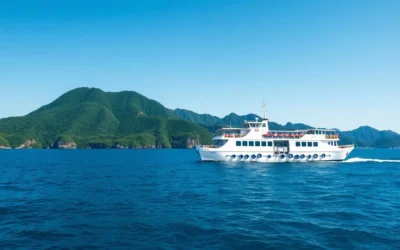✓ Accommodations✓ Flights✓ Rental Cars
Located in northern Japan, Akita is known for its distinct seasonal characteristics, making the time of your visit crucial.
The region experiences four distinct seasons, with significant temperature variations throughout the year, affecting the weather conditions.
To enjoy warm-weather activities, the ideal time to visit is from early June to late September, with the peak tourist season in early August.
Understanding Akita’s climate patterns will help you make informed decisions about when to visit based on your preferences.
Discovering Akita Prefecture: Japan’s Hidden Northern Gem
As you plan your trip to Japan, consider venturing to Akita Prefecture, a region that promises an unforgettable experience with its distinct seasons and rich cultural heritage. Akita Prefecture is a treasure trove of natural beauty, from the snow-capped mountains in winter to the lush greenery of summer, and the vibrant foliage of autumn.
Geographic Location and Climate Overview
Akita Prefecture is located in the Tohoku region, on the northern part of Honshu island. Its geographic diversity includes coastal areas along the Sea of Japan, mountains, and inland regions like the Yokote Basin. This varied landscape contributes to a climate that ranges from humid subtropical to subarctic, with significant seasonal variations.
The climate in Akita is characterized by cold winters with heavy snowfall, particularly in the mountains, and warm, humid summers. Spring and autumn are mild and pleasant, making them ideal time for sightseeing and outdoor activities.
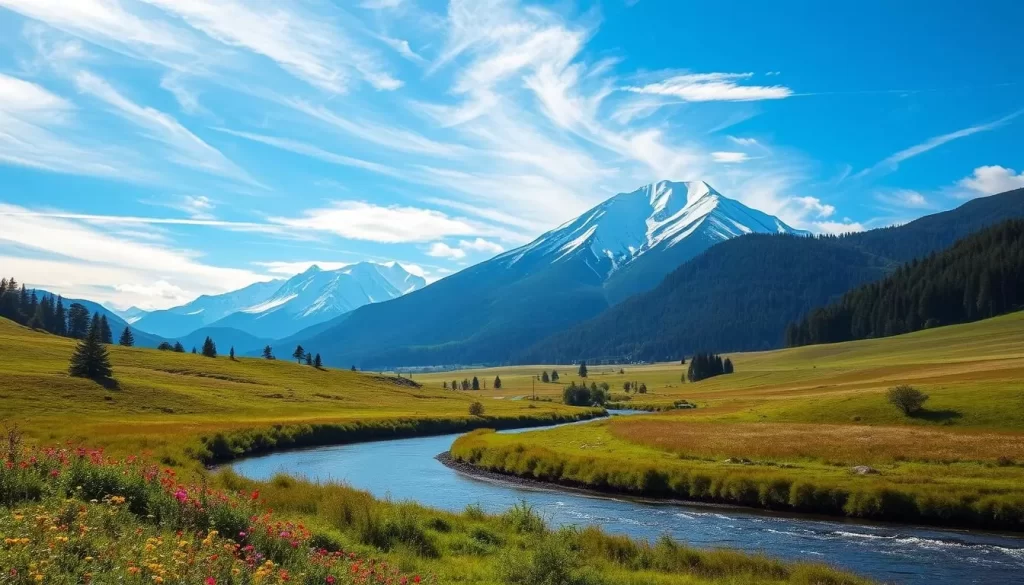
What Makes Akita’s Weather Unique
Akita’s weather is distinct due to its northern latitude and the influence of the Sea of Japan, which brings significant moisture and results in heavy snowfall during winter. This unique weather pattern creates a serene landscape that attracts visitors for travel and winter sports.
In contrast, the summer months bring warmth and humidity, making it essential to plan your visit according to your comfort preferences. Understanding these weather patterns helps you make the most of your trip.
Why Weather Matters for Your Akita Trip
The weather in Akita significantly impacts your travel experience, influencing the activities you can enjoy and the spots you can visit. For instance, Lake Tazawa and the Shirakami-Sanchi forests are best appreciated during specific weather conditions.
By planning around the weather, you can pack appropriately, avoid disruptions, and align your visit with Akita’s seasonal festivals and cultural events, enriching your overall experience.
Understanding Akita’s Four Distinct Seasons
With its location in northern Japan, Akita Prefecture boasts four distinct seasons that are both visually stunning and climatically diverse. As you plan your trip to this beautiful region, understanding the characteristics of each season will help you make the most of your visit.
Seasonal Temperature Patterns
Akita’s temperatures vary significantly across the seasons. In the winter, temperatures can be quite cold, especially in January and February, which are the coldest months. The average high temperature in January, the coldest month, is just 0°C (32°F). In contrast, summer temperatures, while not as hot as in some other parts of Japan, can still be quite warm, with August being the warmest month. Spring and autumn offer mild temperatures, making them ideal for outdoor activities. Spring temperatures gradually rise, while autumn temperatures gradually fall, providing pleasant conditions for sightseeing.
The temperature fluctuations throughout the year are significant, and being prepared for these changes is crucial for a comfortable trip. For instance, the temperature difference between winter and summer can be substantial, so packing layers is advisable.
Precipitation and Snowfall Trends
Akita is known for its significant snowfall during the winter months, making it a popular destination for winter sports enthusiasts. The precipitation patterns in Akita vary by season, with the most significant snowfall occurring between December and March. On average, Akita receives substantially more snow than major Japanese cities, creating a winter landscape that is both beautiful and unique.
In contrast, the summer months experience less precipitation than the winter, but still maintain a level of humidity. Understanding these trends can help you plan your activities and outings accordingly.
How Akita’s Seasons Differ from Tokyo and Other Regions
Compared to Tokyo and other parts of Japan, Akita’s seasons have distinct characteristics. Winters are colder and snowier, with January temperatures averaging 14-18°F lower than in Tokyo. Spring arrives later in Akita, with cherry blossoms typically blooming in mid-April, later than in Tokyo. While summers are slightly less hot, they are still humid. Autumn colors appear earlier in Akita, often beginning in early October, especially in mountainous areas.
These differences make Akita a unique destination, offering experiences that are not available in more temperate or urban areas of Japan. Whether you’re interested in winter sports, cherry blossoms, or autumn foliage, Akita’s distinct seasons provide a diverse range of activities and landscapes to enjoy.
Spring in Akita: Cherry Blossoms and Mild Awakening
The arrival of spring in Akita Prefecture is a treat for the senses. As the cold winter months dissipate, the region transforms into a vibrant landscape, teeming with life and color.
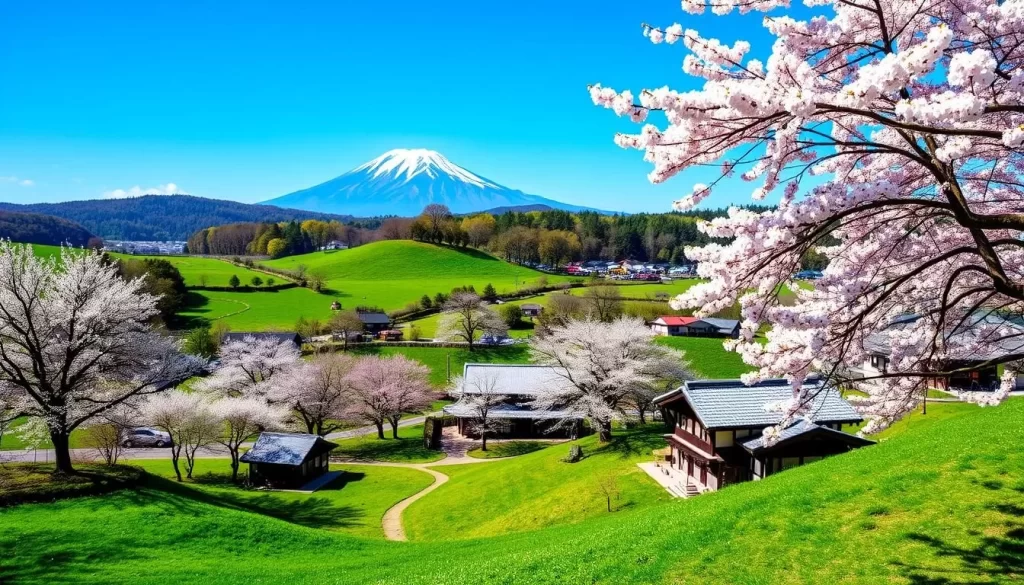
March Weather Patterns and Early Spring Activities
In March, Akita Prefecture begins its transition from winter to spring. Daytime temperatures gradually rise, while nighttime temperatures can still be quite chilly. This period is ideal for those who enjoy cooler weather and fewer crowds, making it perfect for outdoor activities like hiking and exploring the region’s natural beauty.
The average highs in March reach around 50°F, with lows still dipping below freezing. As the month progresses, the snow melts, revealing early spring flowers and greenery.
April’s Cherry Blossom Season: Timing and Best Viewing Spots
April is a highlight of spring in Akita, with the cherry blossoms typically blooming towards the end of the month. The exact timing can vary from year to year, depending on weather conditions.
Popular spots for viewing cherry blossoms include:
- Lake Tazawa
- Shirakami-Sanchi National Park
- Akita City’s Senshu Park
May’s Pleasant Temperatures and Reduced Crowds
May brings increasingly comfortable temperatures to Akita, with daytime highs averaging around 66°F and nighttime lows of 53°F. The weather becomes more stable, with less rainfall compared to the summer months.
After the Golden Week holiday period, tourist numbers decrease, giving visitors more space to explore Akita’s attractions. The landscape is fully awakened from winter, creating picturesque scenery for hiking and outdoor activities.
The month of May is considered one of the best times to visit Japan, and Akita Prefecture is no exception, offering a serene and natural beauty that’s hard to find during peak travel seasons.
Summer in Akita: Festivals, Greenery, and Humidity
Experience the warmth of Akita’s summer, filled with traditional festivals, outdoor activities, and a distinct regional charm. As you travel to this beautiful part of Japan, you’ll find that summer is a vibrant time, full of life and cultural experiences.
June’s Transition and Rainy Season Considerations
June marks the beginning of summer in Akita, but it’s also a time of transition. The weather starts to warm up, but the region is still influenced by the rainy season, known as “tsuyu” or “baiyu.” During this period of increased rainfall, the lush greenery of Akita is particularly vibrant, making it an excellent time for nature walks and enjoying the outdoors.
While the rain can be a consideration for travel plans, it’s also a great opportunity to explore Akita’s cultural sites and indoor attractions. Visitors can enjoy local museums, historical landmarks, and traditional crafts without the peak season crowds.
July-August Heat, Humidity, and Beach Opportunities
As July and August arrive, Akita experiences its warmest months. The heat is accompanied by high humidity, but the coastal areas offer a refreshing escape. You can enjoy beach activities along Akita’s coastline, such as swimming, surfing, or simply relaxing on the sandy shores.
The summer heat also brings an increase in summer festivals, or “matsuri,” which are an integral part of Akita’s cultural heritage. These events are a great way to experience local traditions and interact with the community.
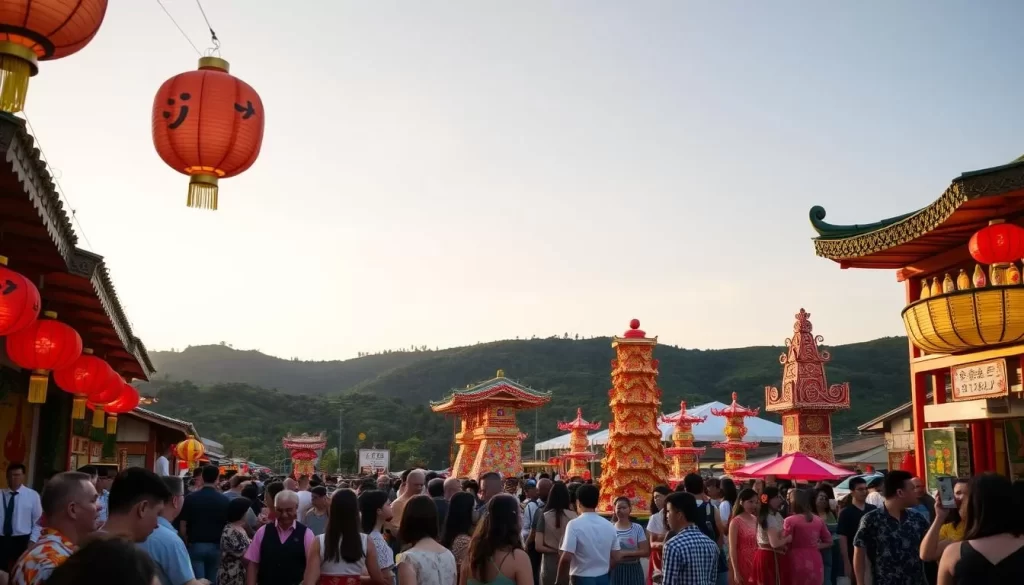
| Month | Weather | Activities |
|---|---|---|
| June | Transition to warmer weather, rainy season | Nature walks, cultural site visits |
| July-August | Warmest months, high humidity | Beach activities, summer festivals |
Summer Festivals and Cultural Experiences
Summer is a time for numerous festivals in Akita, with the Kanto Festival being one of the most famous. Held in Akita City from August 3-6, this event features performers balancing large lantern poles, creating a spectacular display.
Other notable summer events include the Omagari Fireworks Festival in late August, showcasing Japan’s pyrotechnic artistry. Throughout the summer, smaller local festivals take place across Akita’s towns and villages, offering authentic cultural experiences for tourist and locals alike.
These cultural events provide a unique insight into Akita’s traditions and offer opportunities to interact with locals celebrating centuries-old customs. As you travel through Akita during the summer, you’ll have the chance to experience these vibrant festivals firsthand.
Autumn in Akita: Spectacular Foliage and Harvest Season
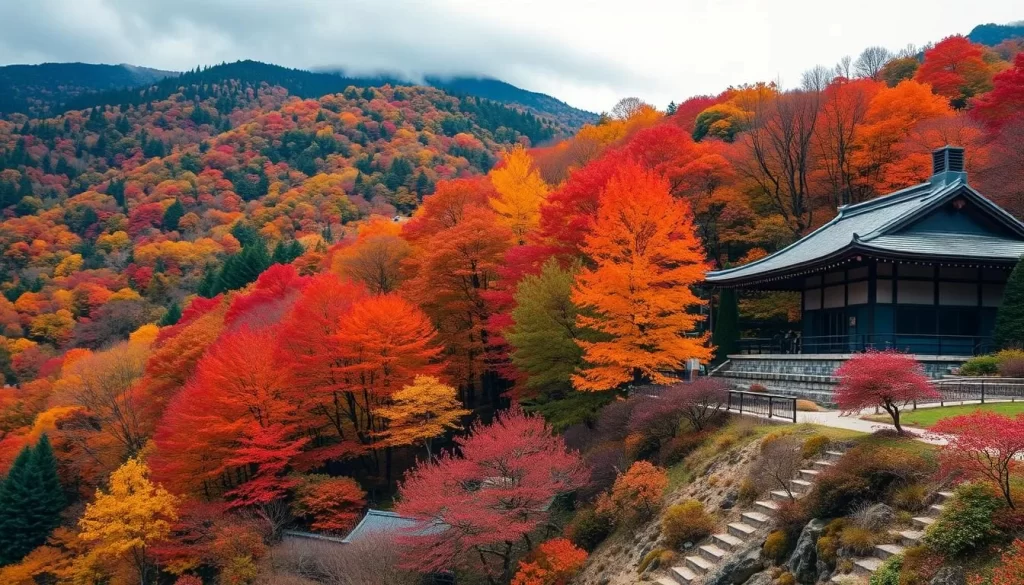
Experience the breathtaking beauty of Akita’s autumn, with its comfortable weather and stunning natural scenery. As the summer heat dissipates, the region transforms into a vibrant canvas of colors, making it an ideal time to visit.
September’s Mild Temperatures and Early Color Changes
September marks the beginning of autumn in Akita, with mild weather and the first signs of color change. Daytime temperatures are pleasant, while nighttime temperatures begin to cool down, creating a comfortable climate for outdoor activities. It’s an excellent month to enjoy the early foliage and participate in harvest-related events.
October’s Peak Foliage and Ideal Hiking Weather
October is the peak autumn month in Akita, with the foliage reaching its most spectacular. The weather is generally clear and crisp, making it an ideal time for hiking and exploring the region’s natural beauty. The comfortable temperatures and vibrant colors make October a highlight of the year.
November’s Cooling Trend and Pre-Winter Activities
November in Akita sees a significant cooling trend, with average daytime highs of 51°F and nighttime lows of 40°F. The weather becomes noticeably cooler, especially in the latter half of the month. While the peak foliage season is ending, early November often still offers beautiful late autumn colors in lower elevations and coastal areas. The relatively dry conditions and clear skies make it an excellent time for sightseeing before winter arrives.
As the year progresses towards winter, Akita’s autumn season provides a unique blend of natural beauty and cultural experiences. Whether you’re interested in foliage, harvest festivals, or simply enjoying the mild weather, Akita’s autumn is a wonderful season to visit.
Winter in Akita: Snow Country at Its Finest

Winter in Akita is a time of wonder, with snow-covered landscapes, unique festivals, and warm cultural experiences awaiting visitors. As the cold weather sets in, the region transforms into a serene and picturesque destination, perfect for those who enjoy winter sports, festive atmosphere, and traditional Japanese celebrations.
December’s Transition to Winter Wonderland
December marks the beginning of winter in Akita, with temperatures gradually dropping and snowfall becoming more frequent. The region starts to take on a serene, snow-covered landscape, setting the stage for the festive season. Visitors can enjoy early winter activities such as skiing and snowshoeing, while experiencing the local culture and cuisine.
January-February: Peak Snow Season and Winter Sports
January and February are the peak months for snow in Akita, with heavy snowfall and cold temperatures creating ideal conditions for winter sports. Visitors can enjoy a range of activities, including skiing, snowboarding, and ice skating, at various resorts and facilities throughout the region. The snow-covered landscapes also offer opportunities for snowshoeing, hot springs visits, and other winter experiences.
Winter Festivals and Unique Cultural Experiences
Akita’s winter is not just about snow; it’s also a time for unique festivals and cultural experiences. The famous Namahage Festival on New Year’s Eve features demon-like beings visiting homes to frighten children into good behavior. The Yokote Kamakura Festival in February showcases hundreds of snow huts (kamakura) illuminated by candles, creating a magical winter landscape. Visitors can also enjoy special seasonal cuisine, including kiritanpo hot pot and warming sake, perfect for cold winter evenings.
These winter cultural experiences offer insights into how Akita’s people have adapted to and celebrated their snowy environment for centuries. The festivals and traditions are a testament to the region’s rich cultural heritage and its ability to turn the challenges of heavy snowfall into unique opportunities for celebration and community bonding.
Akita Prefecture, Japan: Best Months for a Weather-Savvy Trip
To enjoy Akita Prefecture to the fullest, it’s crucial to choose the right time for your trip, considering its seasonal weather patterns. Akita’s climate varies significantly throughout the year, offering diverse experiences for travelers who plan their visit accordingly.
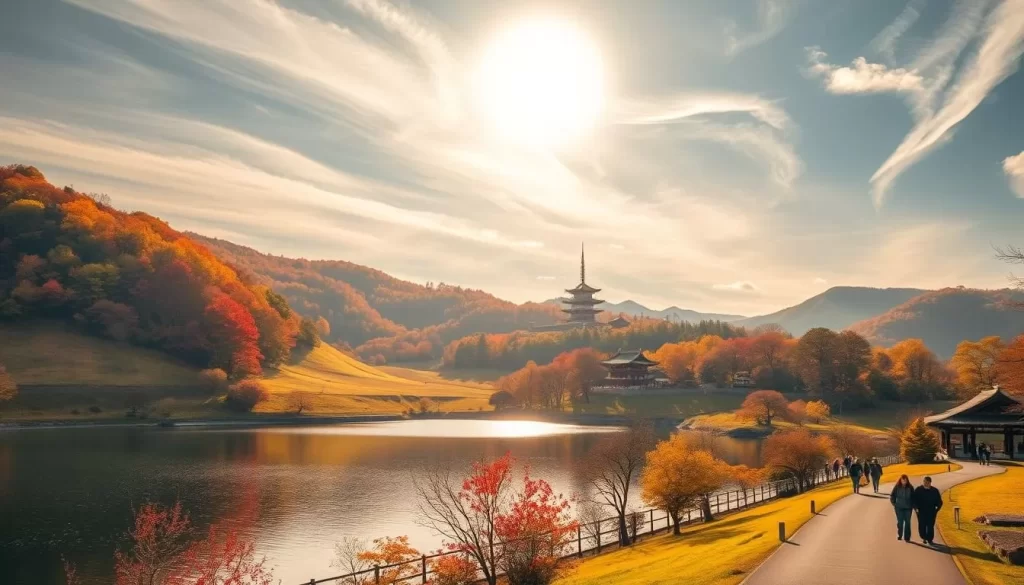
Top 3 Months for Ideal Weather Conditions
When planning your travel to Akita, identifying the months with the most favorable weather is key. The top three months for ideal weather conditions are typically May, September, and November.
May offers pleasant temperatures, with average highs around 20°C (68°F), making it perfect for outdoor activities without the summer heat. September brings warm, yet comfortable weather, ideal for enjoying Akita’s natural beauty before the autumn colors peak.
November is another excellent month, with crisp, clear days that follow the autumn foliage, providing a serene and picturesque landscape.
Months to Avoid and Why
While Akita has its charm throughout the year, there are certain months that are less ideal for visiting due to extreme weather conditions. July and August are characterized by high humidity and temperatures, which might be uncomfortable for some travelers.
January and February, while perfect for winter sports enthusiasts, bring very cold temperatures and significant snowfall, which could limit accessibility to some areas.
Shoulder Season Advantages for Budget Travelers
For tourists on a budget, considering the shoulder season can be highly beneficial. Periods like late April, late May to early June, September, and November offer a great balance between favorable weather and lower prices.
During these shoulder seasons, you can enjoy significant cost savings, with accommodation prices often 20-30% lower than during peak periods. Not only will you save money, but you’ll also experience a more authentic Akita with fewer tourists, allowing for more meaningful interactions with locals.
Late April provides pleasant spring weather, September offers warm conditions without the summer crowds, and November presents crisp, clear days after the autumn color peak. These periods are ideal for travelers looking to avoid the peak season hustle while enjoying good weather and lower costs.
Planning Around Akita’s Precipitation Patterns
To make the most of your visit to Akita, it’s essential to understand its precipitation patterns. Akita Prefecture experiences a unique climate with significant precipitation variations throughout the year.
Rainy Season Timing and Impact on Travel
Akita’s rainy season typically occurs during the summer months, with June being a critical period. The rain can impact outdoor activities, but it also brings lush greenery to the region. You should be prepared for humidity and potential rain showers during this time. The rainy season is a less crowded period, making it an excellent time for those who prefer fewer tourists.
During the rainy season, some outdoor activities may be limited, but there are still plenty of cultural experiences and indoor activities to enjoy. You can explore local museums, visit historical sites, or indulge in the local cuisine.
- Be prepared for rain and humidity
- Enjoy fewer crowds and lower prices
- Explore indoor activities and cultural experiences
Snow Accumulation: What to Expect and When
The snowy period in Akita lasts from late November to mid-March, with January being the snowiest month, receiving an average accumulation of 4.0 inches of snow. February follows closely with 3.3 inches. You can expect significant snowfall in the mountainous areas, making it an ideal destination for winter sports enthusiasts.
The reliability of Akita’s winter snow is a significant advantage for those planning to engage in snow-related activities over several days or throughout the year. The snow season at ski resorts typically runs from mid-December through early April.
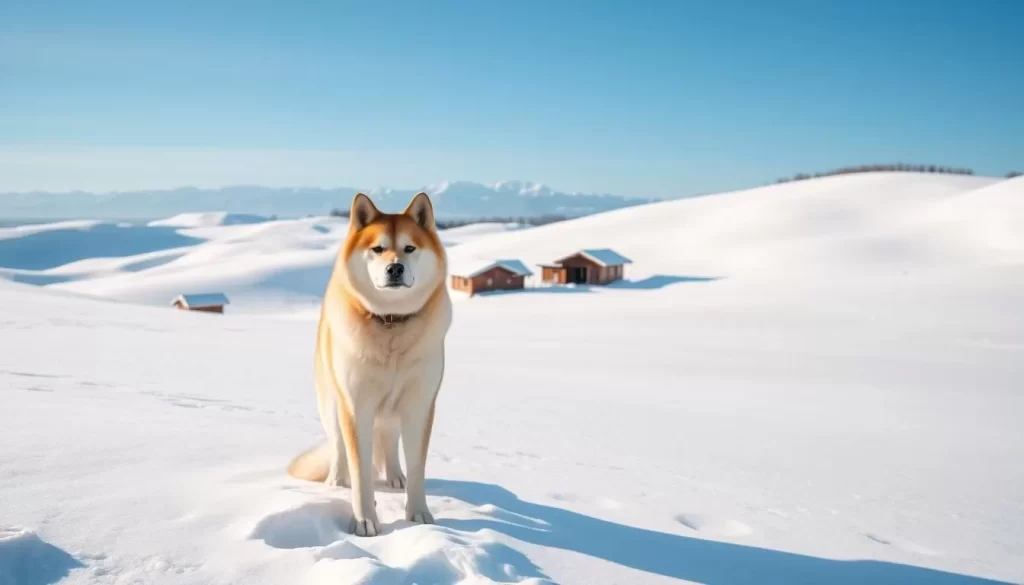
- January and February are the peak snow months
- Mountainous areas receive substantial snowfall
- Snow season is ideal for winter sports
Packing Essentials for Akita’s Variable Climate
Packing for Akita’s climate can be a challenge, but with the right strategy, you’ll be prepared for anything the weather throws your way. Akita’s diverse climate, ranging from cold snowy winters to mild spring and fall, requires careful consideration when it comes to packing. Understanding the weather patterns throughout the year is crucial for a comfortable trip.
Spring and Fall: Layering Strategies
During spring and fall, layering is key to comfort. You’ll want to pack clothing that can be layered to adjust to changing temperatures. Thermal base layers made of materials like wool or synthetic fabrics are ideal for cooler mornings and evenings, while lighter layers can be worn during warmer afternoons. Consider packing clothes that can be easily mixed and matched to create multiple outfits. This approach will help you stay comfortable during your trip, regardless of the time of day.
Summer Comfort: Dealing with Humidity
Summer in Akita can be warm and humid, so it’s essential to pack lightweight, breathable clothing that will keep you cool. Don’t forget to include items like sunscreen, a hat, and sunglasses to protect yourself from the sun. Staying hydrated is also crucial, so consider packing a refillable water bottle.
Winter Necessities: Beyond Basic Cold Weather Gear
Winter in Akita is cold and snowy, with average highs ranging from 36-41°F and lows of 28-32°F. To stay warm, you’ll need serious winter gear, including waterproof boots with good traction, insulated gloves, and a warm hat that covers your ears. A waterproof and windproof outer layer is also essential, as Akita’s winter often combines snow with significant wind. Consider bringing traction aids like slip-on ice cleats to help with icy sidewalks and streets.
Akita’s Natural Attractions: Best Weather Windows
From serene lakes to rugged coastlines, Akita’s natural attractions are best appreciated during specific times of the year. Understanding these optimal periods can significantly enhance your experience.
Lake Tazawa: Optimal Visiting Conditions
Lake Tazawa, Japan’s deepest lake, offers breathtaking scenery that varies with the season. The best time to visit is during spring and autumn when the weather is mild and the surrounding foliage is particularly vibrant.
Summer can be pleasant for those who enjoy water activities, while winter transforms the area into a serene, snow-covered landscape.
Shirakami-Sanchi: Weather Considerations for Hiking
Shirakami-Sanchi, a UNESCO World Heritage site, is renowned for its primeval Siebold’s beech forests. The ideal weather for hiking in this area is during the spring (May) and autumn (September to October), when temperatures are moderate and rainfall is relatively low.
Be prepared for sudden weather changes, as the region can experience rapid shifts in conditions.
Coastal Areas: Timing for Best Experiences
Akita’s Sea of Japan coastline offers diverse experiences throughout the year. You’ll find the coastal areas most accessible and enjoyable from late June through September, making it a great time for a visit.
August is particularly popular due to the warm sea temperatures, reaching around 77°F, making it ideal for swimming. In contrast, spring and fall provide excellent conditions for coastal hiking and photography with fewer visitors.
Cultural Festivals and Weather Connections
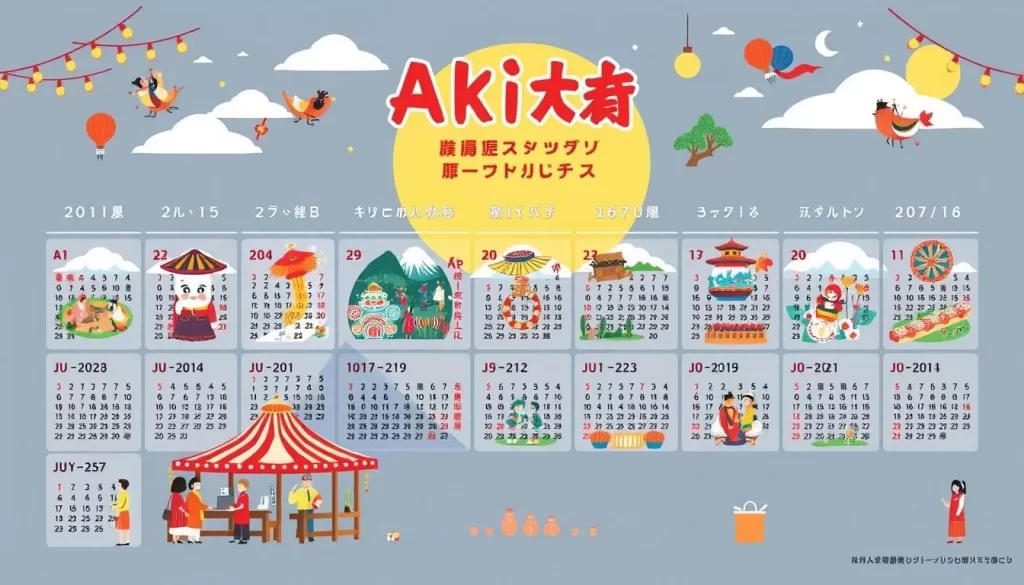
Discover how Akita’s cultural festivals are intricately linked with the local weather, creating a truly immersive experience for visitors. Akita Prefecture is renowned for its rich cultural heritage, with numerous festivals taking place throughout the year. These events are often closely tied to the seasonal weather patterns, making the local climate an integral part of the cultural experience.
Seasonal Festivals Worth Planning Around
The festivals in Akita are a significant part of the cultural identity, with many events worth planning your trip around. For instance, the Akita Kanto Matsuri, held in August, is a spectacular display of traditional dance and music, taking place during one of the warmest months of the year. In contrast, the Omachiya Festival in December brings a festive atmosphere to the cold winter nights, with illuminations and traditional performances.
Other notable festivals include the Tsuruoka Kanga Festival in July, which features traditional dances and floats, and the Akita Namahage Festival, held in February, showcasing a unique and energetic performance where participants dress up as namahage, traditional demon-like figures.
Indoor Cultural Experiences for Inclement Weather
Akita offers numerous indoor cultural experiences for rainy or snowy days. You’ll find plenty of engaging indoor activities to enrich your travel experience. The Akita Museum of Art houses an impressive collection, including works by internationally renowned artist Tsuguharu Foujita, providing cultural enrichment regardless of outside weather conditions.
Traditional craft workshops offer hands-on experiences creating Akita’s famous cedar woodwork or washi paper, allowing you to take home a personally crafted souvenir. Sake brewery tours become especially appealing during cold or wet weather, with many offering tastings of Akita’s award-winning rice wines. Culinary experiences like cooking classes teaching local specialties provide both shelter from inclement weather and deeper insights into Akita’s food culture.
Transportation Considerations by Season
As you plan your visit to Akita, it’s essential to consider how the different seasons affect the transportation options available to you. Akita Prefecture’s transportation network is intricately linked with its seasonal changes, influencing everything from road conditions to the frequency of public transport services.
Winter Travel Challenges and Solutions
Winter in Akita can be harsh, with significant snowfall affecting road conditions and transportation services. Many rural areas become less accessible due to heavy snow, and some roads may close. However, Akita’s infrastructure is well-equipped to handle winter conditions. You can expect:
- Regular clearing of major roads
- Specialized winter tires on public and rental vehicles
- Adapted bus schedules, though some services may be reduced
It’s crucial to check the latest weather forecasts and road conditions before heading out, especially if you’re planning to travel to more remote areas.
Rainy Season Impact on Getting Around
During Akita’s rainy season, typically in June, you should be prepared for potential disruptions in transportation. While the rain doesn’t usually cause the same level of disruption as snow, it’s still important to:
- Monitor weather forecasts
- Be aware of possible delays in bus and train schedules
- Consider indoor activities or flexible travel plans
Understanding these challenges can help you plan your travel itinerary more effectively, ensuring a smoother journey during this time.
Best Seasons for Rural Exploration
The best time to explore rural Akita is during late spring (May) and autumn (September-October). These seasons offer:
- Comfortable temperatures
- Good road conditions
- Beautiful scenery, with cherry blossoms in spring and vibrant foliage in autumn
- More frequent public transportation services to rural areas
- Fully accessible seasonal roads that are closed during winter
Visiting during these optimal months allows you to experience the authentic beauty of Akita’s countryside with fewer tourists than the peak summer season, making for a more authentic experience.
Comparing Akita to Neighboring Prefectures’ Weather
To make the most of your trip to Northern Honshu, it’s vital to understand how Akita’s weather compares to that of Aomori and Iwate. While these prefectures share some similarities, there are distinct differences that can impact your travel plans.
The weather patterns in Akita, Aomori, and Iwate are influenced by their geographical locations. Akita, located on the Sea of Japan side, experiences heavy snowfall during winter, while Iwate, on the Pacific side, has a drier winter climate.
Akita vs. Aomori: Weather Differences
Akita and Aomori share some similarities in their weather patterns due to their proximity. However, Aomori’s weather is more varied, with the western part experiencing heavy snowfall like Akita, while the eastern part has a drier climate.The average snowfall in Akita is significantly higher than in western Aomori. Understanding these differences can help you plan your itinerary, especially if you’re planning to visit both prefectures.
Akita vs. Iwate: When to Choose Which
Iwate’s weather is generally drier during winter compared to Akita, making it a good alternative if you’re not fond of heavy snow. However, Iwate is more prone to typhoons during summer and autumn.If you’re looking for a beach vacation, Iwate’s coastline offers a more extensive range of options. On the other hand, Akita’s coastal areas are less affected by typhoons, making them a better choice during the summer months.
Regional Weather Patterns of Northern Honshu
The weather in Northern Honshu is characterized by a distinct split between the Sea of Japan side and the Pacific side. The central mountain range creates a divide, resulting in different climate zones.Understanding these regional patterns can help you plan a more efficient itinerary, taking advantage of the best weather conditions in each area. The “wave” of cherry blossoms and other seasonal phenomena move northward and into the mountains, creating a gradual change in seasons across the region.
By comparing Akita’s weather to its neighboring prefectures, you can make informed decisions about your travel plans, ensuring a more enjoyable and weather-savvy trip to Northern Honshu.
Accommodation Strategies for Different Seasons
Akita Prefecture’s varied weather conditions make it essential to pick the right type of accommodation for your visit. Different accommodation types offer varying levels of weather protection and seasonal comfort, ensuring that you have a pleasant stay throughout the year.

Onsen Experiences: Weather-Based Recommendations
Akita is renowned for its onsen (hot springs), offering a unique experience, especially during the cold winter months. Visiting an onsen is a great way to warm up and relax. For the best experience, consider staying at a ryokan that offers onsen facilities. The natural hot springs are particularly enjoyable during winter, as the contrast between the cold air and warm water creates a magical atmosphere.
Some ryokan offer outdoor onsen (rotenburo) with views of snow-covered landscapes, enhancing the overall experience. When booking, look for establishments that maintain their onsen year-round, ensuring you can enjoy this relaxing activity regardless of the season.
Peak vs. Off-Season Pricing and Availability
The time of year significantly affects accommodation pricing in Akita. Peak seasons, such as cherry blossom season in spring and peak foliage in autumn, attract many visitors, leading to higher prices. Conversely, the off-season often brings more affordable rates, making it an attractive option for budget-conscious travelers.
It’s crucial to plan ahead and book your accommodation well in advance, especially during peak seasons, to secure the best place to stay. Consider visiting during the shoulder season for a balance between comfortable weather and reasonable prices.
Weather-Appropriate Accommodation Types
Akita offers a range of accommodation types, each with its unique characteristics. Modern hotels provide consistent climate control throughout the year, making them suitable for extreme weather conditions. Traditional ryokan, on the other hand, offer atmospheric experiences, with features like irori (hearth) fireplaces in winter or serene garden views that change with the seasons.
For winter visits, prioritize accommodations with reliable heating systems, as older buildings can be drafty. During the rainy season, look for places with indoor activities or covered common areas to ensure a comfortable stay.
Day Trip Weather Planning from Akita City

Whether you’re heading to the mountains or the coast, checking the weather forecast is a vital step in planning a day trip from Akita City. The region offers a diverse range of experiences, from scenic hiking trails to cultural landmarks, each affected by the prevailing weather conditions.
Weather-Dependent Day Trip Options
The time of year and prevailing weather conditions significantly influence the choice of destination for your day trip. In clear weather, the scenic beauty of Lake Tazawa, Japan’s deepest lake, is a must-see. On the other hand, the Shirakami-Sanchi mountains offer breathtaking hiking trails during the mild seasons.
For a day trip to be memorable, it’s crucial to choose a destination that aligns with the current weather. For instance, during the autumn, the foliage around Kakunodate is spectacular, making it an ideal place to visit.
Rainy Day Alternatives Near Major Towns
On a rainy day, Akita City itself offers several indoor attractions. You can visit the Akita Museum of Art, which features an impressive collection, including works by Tsuguharu Foujita. Another option is the Akita Senshu Museum of Art, providing a cultural escape from the rain.
In other major towns, museums like the Denshokan Museum in Kakunodate and the Namahage Museum on Oga Peninsula are excellent alternatives. Additionally, traditional craft workshops throughout the prefecture offer hands-on experiences, such as making Akita’s famous cedar woodwork or washi paper. Sake brewery tours also become particularly appealing on rainy days, with several historic producers offering tours and tastings.
For culinary experiences, consider cooking classes that teach local specialties like kiritanpo (pounded rice on skewers). Shopping arcades in Akita City and covered shopping streets in smaller towns provide protection from the elements while allowing you to browse local products and souvenirs, making for a pleasant day out, regardless of the weather.
Conclusion: Creating Your Weather-Perfect Akita Itinerary
Akita’s diverse climate means that the best time to visit depends on what you’re looking for in your travel experience. Whether you’re drawn to cherry blossoms in the spring, vibrant summer festivals, spectacular autumn foliage, or the serene beauty of winter snow, understanding the seasonal weather patterns is key to planning an unforgettable trip.
For the most pleasant overall weather conditions, consider visiting in May or October, when temperatures are comfortable and precipitation is moderate. If you have specific interests, plan accordingly: mid-late April for cherry blossoms, early August for summer festivals, mid-October for autumn colors, and January-February for snow experiences.
Building some flexibility into your itinerary is wise, as Akita’s weather can change quickly in any season. You may also want to consider combining your Akita visit with neighboring prefectures, taking advantage of the seasonal progression of weather patterns across northern Japan. By doing so, you’ll not only maximize your enjoyment of Akita’s natural landscapes and cultural traditions but also experience the unique charm of the region.
Whatever time of year you choose for your Akita adventure, you’ll discover a region of Japan that remains refreshingly authentic and less crowded than many more famous destinations. So, take advantage of the seasonal specialties in food, festivals, and natural phenomena that make every time of year in Akita special in its own way.
With this knowledge, you’re now equipped to create a weather-savvy Akita itinerary that aligns with your personal interests and comfort preferences. Enjoy your trip and make the most of your travel experience in this beautiful Japanese prefecture.
The above is subject to change.
Check back often to TRAVEL.COM for the latest travel tips and deals.






